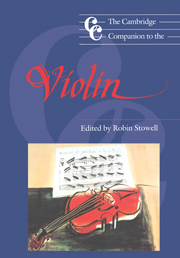Book contents
- Frontmatter
- 1 The violin and bow – origins and development
- 2 The physics of the violin
- 3 The violinists of the Baroque and Classical periods
- 4 The nineteenth-century bravura tradition
- 5 The twentieth century
- 6 The fundamentals of violin playing and teaching
- 7 Technique and performing practice
- 8 Aspects of contemporary technique (with comments about Cage, Feldman, Scelsi and Babbitt)
- 9 The concerto
- 10 The sonata
- 11 Other solo repertory
- 12 The violin as ensemble instrument
- 13 The pedagogical literature
- 14 The violin – instrument of four continents
- 15 The violin in jazz
- Appendix Principal violin treatises
- Glossary of technical terms
- Notes
- Select bibliography
- Index
15 - The violin in jazz
Published online by Cambridge University Press: 28 September 2011
- Frontmatter
- 1 The violin and bow – origins and development
- 2 The physics of the violin
- 3 The violinists of the Baroque and Classical periods
- 4 The nineteenth-century bravura tradition
- 5 The twentieth century
- 6 The fundamentals of violin playing and teaching
- 7 Technique and performing practice
- 8 Aspects of contemporary technique (with comments about Cage, Feldman, Scelsi and Babbitt)
- 9 The concerto
- 10 The sonata
- 11 Other solo repertory
- 12 The violin as ensemble instrument
- 13 The pedagogical literature
- 14 The violin – instrument of four continents
- 15 The violin in jazz
- Appendix Principal violin treatises
- Glossary of technical terms
- Notes
- Select bibliography
- Index
Summary
It is often assumed that the violin has had only a small role in jazz and related musics, although in fact its achievement has been quite large and varied. The roots of this diversity lie in the wide range of musics that contributed to jazz and allied forms. Jazz began in the USA, whence countless immigrants travelled from Europe, plus many involuntary immigrants from Africa. They all took with them their music, which the new world changed, and it may be that the most significant aspect of jazz in particular is the extent to which it has reflected the mixture of cultures and races that characterises the country in which it emerged.
The violin's place in all this goes back a long way. In Music in New Orleans: the Formative Years 1791–1841 (Baton Rouge, 1967) Henry Kmen writes that ‘as early as 1799 fifes and fiddles were used’ by the city's slaves. One line of descent from those times may be glimpsed in Yodelling Blues by the Buck Mt Band (OKeh 45428, 1929), where Van Edwards's fiddle reminds us of both country music and blues. So does the Johnson Boys' Violin Blues (OKeh 8708, 1928), except that Lonnie Johnson's violin, with its double-stopped imitations of train noises, anticipates the railway onomatopoeics of boogie pianists and more especially of the Quintette du Hot Club de France's Mystery Pacific (HMV B8606, 1937), and hence is closer to jazz.
- Type
- Chapter
- Information
- The Cambridge Companion to the Violin , pp. 249 - 256Publisher: Cambridge University PressPrint publication year: 1992



